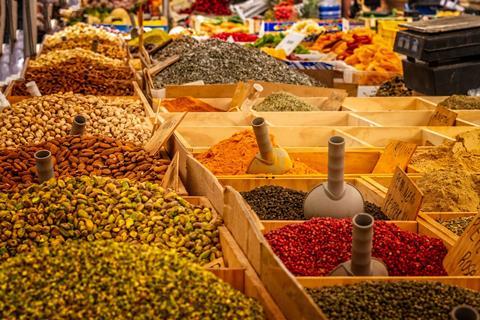The World Health Organisation (WHO) has reported that unsafe food causes 600 million cases of foodborne diseases and 420,000 deaths a year, worldwide. 30% of foodborne deaths occur among children under 5 years of age. They also estimate that 33 million years of healthy lives are lost due to eating unsafe food globally each year and that this number is likely an underestimation. According to Francesco Branca, the director of the Department of Nutrition and Food Safety (WHO), 1 in 10 people are affected by foodborne disease every year. World Food Safety Day is just around the corner, the theme of which for this year is “Food safety: prepare for the unexpected”.
How can we feed the surging population with safe and nutritious food? This long-lasting and pivotal question has been tackled across different sectors and dimensions for years. Addressing food safety alone is challenging, let alone the fact that we are inundated with other unrelenting pressures such as climate change and extreme weather events such as flooding, each of which threaten food safety. “Brexit” and other examples of geopolitical instability such as the Russian-Ukraine War, and the Israel-Gaza crisis all add instability and uncertainty to the supply chain, along with the potential outbreak of another pandemic and animal diseases such as bird flu or swine influenza. Some of the most limiting factors that can directly impact food safety are the implementation of uniform safety standards among the food and grocery industry, tight control of good food hygiene practices followed from farm to fork, consumer awareness and knowledge of food safety, and most importantly, socioeconomic status. Ongoing inflation limits choices and access to safe and healthy fresh produce for low-income groups. Feeding an ever-increasing population with safe and nutritious food is challenging, especially as foodborne diseases can occur at different stages and have even more debilitating effects in impoverished or underdeveloped regions.
“Governments and industry must have plans in place in case of an unexpected event, and ensure no time is wasted in implementing the necessary actions”. - Corinna Hawkes, the director of the Food Systems and Food Safety Division, FAO
Francesco Branca (WHO) also emphasises that “the rapid exchange of information and effective communication, food safety management plans and decisive action by food operators all help save lives. At home, consumers’ food safety knowledge can avert problems in unexpected situations.” The messages are clear: there is no single or fixed solution to this intricate problem. Translating them into actionable plans to safeguard food safety is still demanding, and therefore, we need collective efforts and innovative approaches to reduce the risk of contaminated foods and their exposure to consumers from different levels. This involves the government, industry, academia, and consumers.

Transitioning from the global perspective of food safety to a concrete example, the US response to E. coli O157:H7 outbreak linked to ground beef demonstrated the successful story that government and industry can work together to mitigate food safety. With the trend of plant-based meats or alternative proteins, despite their benefits for both the environment and health, the emerging need for novel foods also poses a challenge for the food industry – namely, to cope with potential microbial contaminations during production and packaging, making sure the safety complies with regulations. Notably, fungi produce mycotoxins which are widespread and continue to increase in many countries The mycotoxins are present in different crops and foodstuffs such as cereals, nuts, and fruits after which adverse health effects can develop via the direct consumption of contaminated foodstuffs or products derived from animals fed on the contaminated feed. There is also evidence that people can suffer from immune deficiency and cancer if exposed in the long term. Luckily, the WHO and FAO Expert Committee on Food Additives (JECFA) are in place to set the standard for the assessment and provide risk management advice.
Essentially, mycotoxins are naturally occurring secondary metabolites, and there are more than 500 mycotoxins have been reported, so rapid detection and monitoring of mycotoxin levels in the first place is key for industry and government in order to prevent any harm to the public. The traditional method is to employ analytical techniques such as liquid chromatography with tandem mass spectrometry (LC-MS/MS), as they are sensitive and robust to quantitatively analyse the targeted known mycotoxins. Unprecedented warmer weather increases the frequency of the outbreak of aflatoxins, one of the most studied mycotoxins in the world, produced by two species of Aspergillus. More robust detection and quantification methods are still needed to accurately measure aflatoxin-derived metabolites from different strains of Aspergillus. This will alleviate the disturbing impacts associated with child stunting and cancer from exposure to aflatoxins.

However, with the demand to understand foodborne microbes in the industry to prevent any damage or costs. As well as basic microbiology culture and testing assays in the traditional setting (which are essential), sequencing-based approaches are increasingly improved and are widely accepted in the food industry. For example, 16S rRNA sequencing is a cheaper and more rapid way to assess bacterial species, whereas shotgun sequencing is a slightly more expensive but more powerful tool to identify entire microbial communities. It is reassuring that the combination of metagenomics and chemical analysis is already applied in grain storage. We know that early detection in production is the first step to reducing mycotoxin risks, and inspection of packaging and shipment are also indispensable. However, the funding support for food security is inadequate, especially in developing regions such as parts of Africa. Despite the ongoing collaboration between industry and academics to grapple with food safety research, the government still needs to continue its funding support and foster communication between different sectors.
Consumers are encouraged to buy fresh nuts and grains, have diverse choices of food to reduce toxins improve nutrition, and be aware of the appropriate storage conditions. According to FAO, 30-40% of foodborne illnesses are due to poor hygienic practices in the household. This is not only the consumers’ responsibility but also interconnects with food labelling and public involvement. Public education programmes or campaigns enable people to access information about food safety and knowledge with ease. Raising awareness of food safety is crucial and rewarding too. In turn, this reduces the financial burden for the government to invest in treating infections or diseases associated with food poisoning and other health complications regarding food safety.

It is not difficult to recognize that food safety issues are prevalent in developing countries, and this may result in the implementation of different policies and measures compared to most developed countries. Food safety issues are more severe in Africa which heavily relies on staple crops. We should not neglect that crops rejected due to mycotoxin contaminations are more likely to be eaten by vulnerable people who cannot afford to buy healthier and fresh produce, and this urges us to be more tailored and specific, rather than having one-size-fit-for-all approaches to solving food safety issues. In addition, we need more multidisciplinary and collaborative work in those places where education is poor and training is even more scarce.
Ameliorating food safety is promising and achievable at different levels if each sector works together. This partnership involves governments, farmers, researchers, agricultural organizations, policymakers, health, and development partners, and other relevant stakeholders. Each of them is indispensable to solving this problem. We can all also offer more than we think to safeguard food safety and protect our lives from foodborne diseases.
Further reading
Metagenomics Approaches for Improving Food Safety: A Review - ScienceDirect
Mycotoxins and consumers’ awareness: Recent progress and future challenges - ScienceDirect
Food safety and quality: Public education and communication (fao.org)


No comments yet